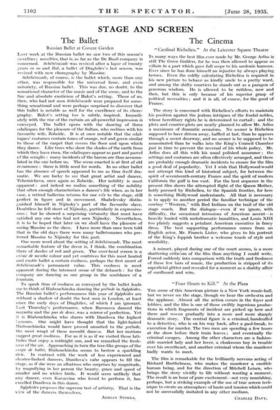STAGE AND SCREEN
Russian Ballet at Covent Garden LAST week at the Russian ballet we saw two of this season's novelties ; novelties, that is, as far as the De Basil company is concerned. Scheherazade was revived after a lapse of twenty years or so and Bal, a ballet of Diaghilev's last season, was revived with new choregraphy by Massine.
Scheherazade, of course, is the ballet which, more than any other, was responsible for the universal fame, and even notoriety, of Russian ballet. This was due, no doubt, to the sensational character of the music and of the scene, and to the fine and absolute exoticism of Ba.kst's setting. Those of us, then, who had not seen Scheherazade were prepared for some- thing sensational and were perhaps surprised to discover that this ballet is notable as well for the excellence of its chore- graphy. Bakst's setting too is subtle, inspired. Immedi- ately with the rise of the curtain an all-powerful impression is conveyed. The ballet opens with the dancing of three odalisques for the pleasure of the Sultan, who reclines with his favourite wife, Zobeide. It is at once notable that the odal- isques' costumes contain tones of orange, red and green similar to those of the carpet that covers the floor and upon which they dance. Like trees who show the shades of the earth from which they have risen, the odalisques appear as part and parcel of the seraglio : many incidents of the harem are thus accumu- lated in the one before us. The scene enacted is at first of old recurrence : there is little need for words. In no other ballet has the absence of speech appeared to me as thus itself dra- matic. We are lucky to see that great artist and dancer, Tchernicheva, once again as Zobeide. Her -nobility is most apparent : and indeed we realize something of the nobility that often enough characterizes a dancer's life when, as in her case, a retired ballerina returns for one role to the stage, still perfect in figure and in movement. Shabelevsky distin- guished himself in Nijinsky's part of the favourite slave. Doubtless he fell short of Nijinsky, particularly in expressive- ness ; but he showed a surprising virtuosity that must have satisfied any one who had not seen Nijinsky. Nevertheless, it is to be hoped that later on we shall have the pleasure of seeing Massine as the slave. I have more than once been told that in the old days there were many balletomanes who pre- ferred Massine to Nijinsky for this part.
One more word about the setting of Scheherazade. The most remarkable feature of the decor is, I think, the combination there of shades of red and green. The over-head screen is a creme de menthe colour and yet contrives for this most heated and exotic ballet a certain coolness, perhaps the first secret of Scheherazade's permanent value. This coolness is most apparent during the intensest scene of the debauch : for the company are dancing as one group in the semblance of a fountain.
To speak thus of coolness as conveyed by the ballet leads me to think of Riabouchinska dancing the prelude in Sylphides. The Russian ballet's performances this year of Sylphides are without a shadow of doubt the best seen in London, at least since the early days of Diaghilev, of which I am ignorant. Last Thursday's performance, when Baronova danced the mazurka and the pas de deux, was a mirror of perfection. Yet it is Riabouchinska who shares with Danilova the highest honours. One might have thought that the light-haired Riabouchinska would have proved unsuited to the prelude, the most wrapt of these moonlit dances. But her motions suggest great coolness. For us it is as if we visited those lati- tudes that enjoy a midnight. sun, and we remarked the fresh-
ness of the air. Approaching in turn the tree-like groups of the
corps de ballet, Riabouchinska seems to bestow a sparkling dew. In contrast with the work of less experienced and shorter-limbed dancers, Danilova's vase appears to fill the stage, as if she were an albatross who surprises by magnitude, by magnifying in her person the beauty, grace and speed of smaller and no whiter birds. It would seem unlikely that any dancer, even Karsavina who loved to perform it, has excelled Danilova in this dance.
Sylphides proposes the supreme test of artistry. That is the view of the dancers themselves.
ADRIAN STOKES.






































 Previous page
Previous page